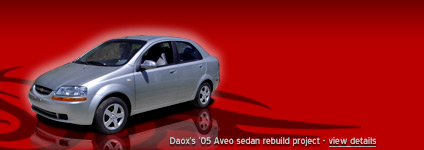Hoosier, I am glad you know what camber is (Knock kneed or bow legged) and if the tires are wearing on the inside tread ribs, then the car has negative camber (knock kneed) the rear suspension frame could be bent. Negative camber allows a car to go around a curve faster but wears tires on the inside ribs. Positive camber usually causes the rear end to roll to the side and if it is very positive it can cause the car to have a lot of body roll or even flip over. I am talking about a lot of positive camber (bow legged).
Shocks and struts (non gas pressurized) are mainly to dampen up and down oscillation.
Way too many shock absorbers are condemned as bad because of age, a very small oil leak or the rubber bottoming bumpers are shiny. If too much oil leaks out, then yes the shock's ability to dampen oscillations decreases. Most of the work a shock does is on its extension stroke, not its compression stroke so when you push a car down, there isn't all that much resistance. If the car rises fast, then the shock isn't doing its job. A few gas filled shocks might lift a car a little. Air shocks (50 to 100 PSI) do lift a car.
The cupped tires on the rear might be because of a serious wheel balance problem and I have seen some cars with wheel balance issues and seriously defective rear shocks. I followed one car where the tires(wheel balance issues) almost hopped off of the road and the AND the back end of the car rose and fell like a bucking bull. That is rare.
OK, Aveo wheels bend easy. I have some extra wheels from a 1984 dodge Caravan 4 cylinder, 4 lug bolt pattern. My steel 14" Aveo wheels weigh 18 pounds. My 84 Caravan wheels weigh 23 pounds each. The junk yard where I bought my extra wheels had 4 or 5 wrecked Aveos and ALL of the wheels were bent on the Aveos and there were no bent 4 hole Caravan wheels that were bent.
About Camber shims, don't buy any ahead of time First the alignment shop has to measure how far the camber is out of specifications. Then they order the shims that will get your car's rear axle back into specifications. If the car's rear alignment initial specification is so bad the shims won't fis it, then the rear suspension frame needs to be replaced.
Point #2 is the rear tires also have toe-in/toe-out or neutral/no toe specification. The preliminary alignment check will determine how much camber each side of the rear axle needs and the slight rotation of the shim should also correct any toe variation from factory specifications.
If any wheels are bent, they need to be replaced before any alignment work. A good alignment technician checks wheel wobble first before he does anything. All wheels have a little run-out and a good alignment mechanic does a Run-out adjustment because attaching the alignment gauges to the wheels is not a precision process. Each time an alignment gauge is attached to a wheel it is off just a little even with perfect wheels. This step is called "compensation for run out" and is done every time a gauge is attached to a wheel. If the compensation for run out isn't done properly and every time the alignment work is worthless. On newer alignment equipment the "compensation for run out"is easy to do but varies by equipment. It wasn't hard on the equipment I used in 1962 but it was a vital step and if not done resulted in tire wear.
As for the pulling, I would have to inspect things so i won't say too much other than rotate the tires right and left to see if the puling seems to follow a tire position.
Different front suspension designs call for different testing procedures to find lose or binding parts so for now i will pass on that topic.



 LinkBack URL
LinkBack URL About LinkBacks
About LinkBacks


 Reply With Quote
Reply With Quote